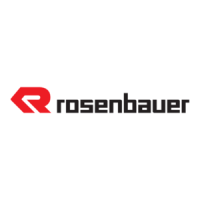
Do you have a question about the Rosenbauer R600 and is the answer not in the manual?
| Brand | Rosenbauer |
|---|---|
| Model | R600 |
| Category | Water Pump |
| Language | English |
Provides contact details for the manufacturer and after-sales service department.
Explains various warning signs used in the manual to highlight potential dangers.
Illustrates and explains prohibition signs and mandatory safety signs.
Details specifications for the R600 pump including manufacturer, design, and connections.
Describes the drive type, shaft seal, casing materials, and operating parameters.
Details specifications for the pump gearbox, including manufacturer, flanges, and materials.
Details specifications for the lantern or bearing block, including manufacturer, flanges, and materials.
Details specifications for the priming pump, including type, operation, and lubrication.
Details specifications for the RVMA 500 foam proportioning system, including type, performance, and accuracy.
Explains the basic components and working principle of the centrifugal pump.
Explains how velocity energy is converted to pressure and operational warnings.
Details the construction of the R600 pump and the features of the suction cover.
Explains the pump's drive mechanism, gearbox, and the cooling system's working principle.
Details the priming system and factors influencing maximum water lift.
Describes the operational principle of the priming pump and its components.
Provides a detailed cut-away view and labeling of the piston priming pump.
Explains the automatic foam system, its advantages, and working principle.
Details the range of use, admixing rates, and accuracy of the RVMA 500 foam system.
Identifies and labels various fittings, controls, and connection points on the pump.
Lists and explains control panel illumination and various warning lamps.
Details various switches for pump operation, valves, and settings.
Outlines pre-operation checks, safety precautions, and cleaning guidelines.
Provides steps for engaging the Power Take-Off (PTO) and starting the pump engine safely.
Details the procedure for operating the pump using tank suction.
Explains how to operate the pump when drafting water from an open source.
Continues the drafting operation procedure and lists important precautions.
Describes the automatic suction and priming operation, including performance notes.
Details the procedure for operating the pump using a hydrant connection.
Covers pressure limits, foam operation during hydrant use, and safety warnings.
Highlights critical safety warnings, including temperature, electrical conductivity, and water hammer.
Explains the operation of the automatic pump pressure governor (DRE) for constant pressure.
Details the DRZ governor operation, including emergency control and failure modes.
Guides on operating the foam system using RVMA 500 from the internal tank.
Guides on operating the foam system using RVMA 500 from an external container.
Lists continuous checks required during pump operation and safety actions.
Provides a step-by-step procedure for safely disengaging the pumping installation.
Describes the procedure for temporarily disengaging the pumping installation.
Details the components of the rapid intervention system and crucial safety warnings for its use.
Explains the operation of the rapid intervention system with water and foam, including safety precautions.
Details the procedure for filling the water tank using the pump, including safety notes.
Describes filling the water tank using the automatic level control system.
Covers uncoupling supply hoses and releasing pressure during automatic tank filling.
Details the procedure for flushing the system after foam operation using the internal line.
Details flushing after foam operation using the external drafting/flushing connection.
Outlines the flushing steps, including priming pump flushing and draining the system.
Provides instructions for operating in cold climates and thorough drainage procedures.
Describes general checking procedures to ensure optimal reliability of the vehicle and installation.
Details the procedure for performing a dry vacuum test to check system tightness.
Emphasizes that service and repair must be done by specialists according to manufacturer guidelines.
Provides instructions for checking and changing the oil in the pump gear box.
Details the oil change and level check for the priming pump.
Covers checking valve plates for contamination and damage, and the priming pump drive belt.
Describes the inspection and greasing intervals for the propeller shaft.
Explains how to manually override the servo motor for the pump pressure governor in case of failure.
Provides guidelines for checking, charging, and maintaining the vehicle battery.
Covers critical battery safety precautions and acid-density levels for charge states.
Details battery charging using the vehicle socket and safe handling of the battery main switch.
Covers cleaning of water/foam tanks and inspection of sacrificial anodes for corrosion protection.
Provides guidelines for storing, packing, and transporting electronic components housed in casings.
Details precautions for handling and packing printed circuit boards to prevent damage.
Outlines storage/transport limits and precautions when working on vehicles with electronics.
Explains methods to prevent electrostatic discharge when testing or working with electronics.
Advises on protecting electronics from debris during drilling/grinding and from paint/liquids.
Lists causes and solutions for pump not operating or having poor priming performance.
Addresses issues like pump noise, vibration, and reduced performance, with corrective actions.